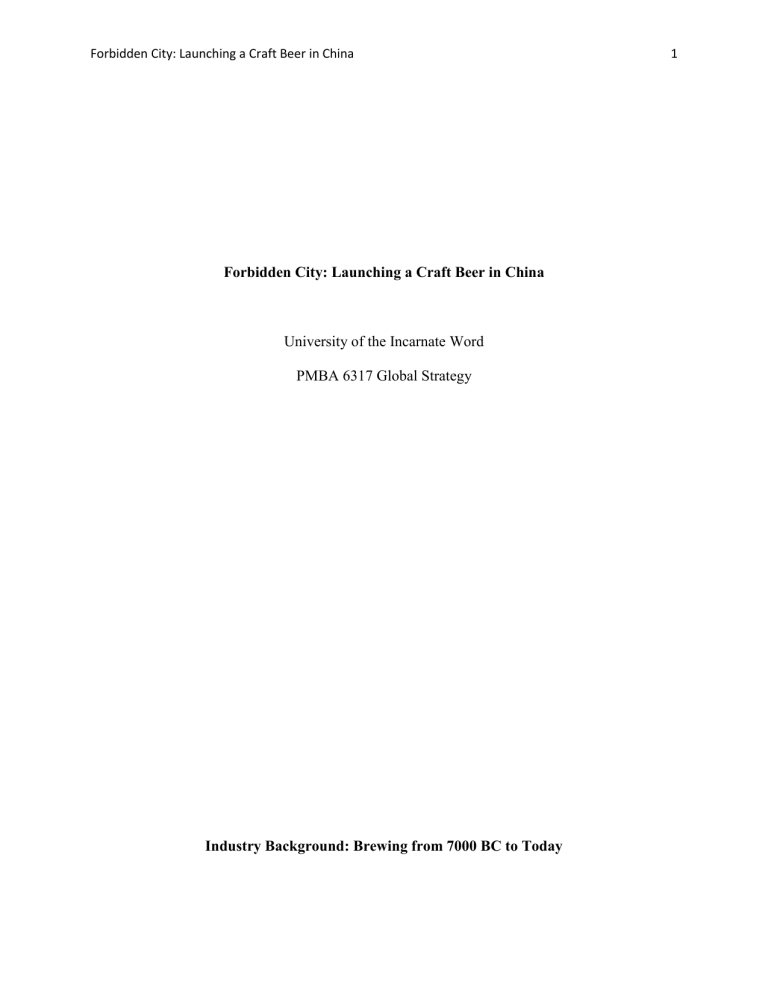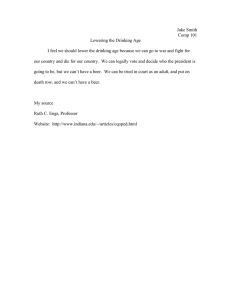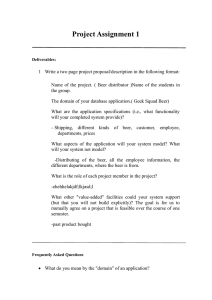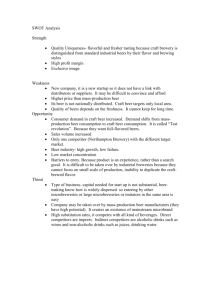
Forbidden City: Launching a Craft Beer in China Forbidden City: Launching a Craft Beer in China University of the Incarnate Word PMBA 6317 Global Strategy Industry Background: Brewing from 7000 BC to Today 1 2 Forbidden City: Launching a Craft Beer in China Beer brewing goes all the way back to the Neolithic Era (Ghose, 2013), when the spread of brewing techniques helped in the cultural transformation that happened when hunter-gatherer cultures evolved into agricultural societies. During the Middle Ages, as monasteries spread across Europe, monks founded small brewing centers through innovations such as the use of hops as a preservative. Consumption rose mostly because of beer being more palatable than water as a result of Europe's abundant barley crops. Numerous regional brewing techniques developed, many of them inspired by the abundance of local crops, resulting in the enormous variety of regional beer varieties available today (Natewebman, 2018). In the 18th and 19th centuries, technical innovations such as the development of hydrometers and other instruments, as well as process innovations such as pasteurization and refrigeration, converted brewing from a highly unpredictable artisanal craft to a reliable manufacturing process. Subsequent advances in transportation, brewing, and distribution allowed beer to be distilled in large amounts and distributed within a large geographic area. By the twentieth century, major breweries had grown in virtually every area, but their features remained shaped by custom and regional differences. In the United States, a succession of agricultural shocks compelled brewers to produce lighter beers with less grain than their European counterparts, who remained rooted in their geographical backgrounds and brewing traditions. Another source of industry variation emerged in the early decades of the century when many European breweries flourished when their American counterparts were constrained by Prohibition and then the Great Depression. Nonetheless, economic growth was pervasive in the decades after World War II. The 1980s and 1990s saw a sea of change, when firms such as Heineken, Carlsberg, and Corona began to promote exports as a means of growth. They accomplished this by establishing a premium global market division for imported beer. Nonetheless, by 1999, even though Coke and Pepsi dominated 3 Forbidden City: Launching a Craft Beer in China 70% of the global soft drink market, the world's four biggest producing companies controlled just 17% of global beer sales. All of that changed with the new century amid a mergers and acquisitions frenzy. By 2018, as annual worldwide alcohol sales reached $700 billion, four firms dominated the industry. Anheuser-Busch InBev (AB InBev) was the largest (Carlsbad, 2015), with a 27 percent market share and a portfolio of 400 brands that included Beck's, Budweiser, and Stella Artois. Heineken N.V. finished in second place, with a 13% global market share, a stable of 300 brands, and operations in more than 200 countries. Molson Coors, with a 5% stake, and Carlsberg Group, with a 4% stake, followed these two behemoths. Apart from supplying almost half of all alcohol consumed worldwide, these four companies reaped 75% of the industry's profits. Due to the significant cost portion of transportation in a global market, profitability was dependent on creating strong demand that was backed up by efficient local growth. As a result, global brewers accelerated horizontal expansion through vertical integration, expanding acquisitions across the value chain, from production to logistics to distribution. Between 2013 and 2018, however, growth slowed, especially in the United States and Europe, where consumer tastes began to shift toward wine and distilled spirits. Subsequently numerous large players increased their emphasis on luxury products in order to preserve profit margins. Upon doing so they encountered rivalry in this sector from emerging craft-beer breweries focused on smallbatch beers that consumers found more compelling and authentic than traditional high-end brews. Global manufacturing conglomerates replied by acquiring craft breweries and creating their own “craft-style” beers. Parallel to this growth strategy, the major players' attention turned to Asia, Latin America, and Eastern Europe. China, which had grown into the world's largest 4 Forbidden City: Launching a Craft Beer in China beer market in terms of production, was one region that piqued the attention of all global competitors. The authors purpose of the article in our opinion is to give in detail the key elements in launching a new product while navigating through strategic, organizational and interpersonal issues that may arise within the process. Le wanted to introduce a new craft beer however Vivian felt there was not enough room for both products to operate in the Chinese market. This left the managing director Wang of Eurasian Brewing Company (EBC) in a tough place with having to decide who he would support; this decision could possibly shape both the company’s future as well as the approach taken by EBC in the fast-growing industry. The tension begins to arise between the two executives when Le announces his plan to introduce a new product, While Vivian is concurrently rolling out a batch of craft beer that she felt strongly about, this tension reached Wang which put pressure on him to make a decision. The Beer Industry in China: An Awakening Giant China, the world's largest beer maker (Chaudhuri, 2015), generated 23% of global production in 2017—more than twice the size of the United States, the world's second largest beer producer. China's beer industry expanded exponentially from 1985 to 2015, fueled by conventional small breweries producing affordable pale lagers. This increase was fueled by a rise in per capita intake from 3 to 30 liters during this time frame. However, recent development had slowed. In 2015, stringent regulatory restrictions on outdoor alcohol, a ban on drunk driving, and consecutive years of poor summer weather resulted in a decrease in usage between 2015 and 2017, resulting in a 1.5 percent decline in industry sales in 2016. Companies who believed they had diversified away from slow-growth economies expressed anxiety about the downturn. They were reminded of international corporations' traumatic encounters in China in the mid-1990s, 5 Forbidden City: Launching a Craft Beer in China when they discovered that their investments in cutting-edge technologies and chic branding could not compensate for the power of established local labels, consumers' price sensitivity, or the arcane distribution mechanism. Many were compelled to vacate their properties, selling them at fire-sale rates. Additionally, both entrants were put through their paces by proven local rivals. China Resources (CR) was the top, with its Snow Beer becoming the world's best-selling beer brand despite being distributed exclusively in China. CR had a 26% market share, while Tsingtao held a 17% share and Beijing Yanjing had a 10% share. AB In Bev reported 16% of the multinational firms, while Carlsberg claimed 5%. The majority was made up of other, lesser players. Though locally made, low-priced pale lagers such as Snow, Tsingtao, Yanjing, and Harbin had traditionally dominated the China beer industry, this segment was mature and was expected to expand at a slower rate than higher-priced segments. Although the category accounted for 21% of volume output, it only accounted for 15% of value production. By comparison, luxury domestic and imported beers marketed at significantly higher prices accounted for 61% of China's $79 billion beer industry. These drinks were traditionally consumed by urbanites with a high standard of living. At the high end, the still faster rising super-premium category accounted for 24% of the industry in terms of volume. However, brands in this market faced growing competition from specialty breweries served in pubs. By 2018, China had launched more than 1,000 craft breweries, including Great Leap Brewing in Beijing and Boxing Cat Brewery in Shanghai. These newcomers brought brews made with a variety of indigenous herbs, including tea, chrysanthemums, and chili peppers. A burgeoning beer community, most evident in larger cities, was propelled along by wealthy young patrons and changing preferences. Even though craft beer revenues grew by more than 40% 6 Forbidden City: Launching a Craft Beer in China between 2015 and 2018 and were forecast to grow by 120 percent between 2018 and 2022, they accounted for just 5% of the super-premium market and 1% of overall beer sales in China. To several international breweries, this new industry pattern mirrored recent developments in their home markets, where craft beers have surpassed premium and super-premium labels in market share. Though foreign breweries were aware of the changes in the Chinese beer industry, many were unsure how to react. Although overall beer consumption was forecast to decline marginally between 2019 and 2023, industry sales were forecast to increase. The projected growth was fueled by a projected move away from mass-market brews toward premium beers as a result of China's rapid growth of affluent customers, especially those in the younger demographic, who were the primary target consumers for beer companies. However, several international breweries approached the business carefully, as reminders of the mid-1990s miscalculations lingered. So far, we have learned that the beer industry is a growing and profitable business with a competitive market. There are daily threats that face the individual owners and industry such as new entrants, substitute products, bargaining power of supplies and buyer as well as rivalry competitors. For one to overcome these unforeseen obstacles it would be wise to prepare and plan by identifying actionable and practical solutions and approaches that are used overtime to stay sustainable. Giving one the opportunity to penetrate into an existing market where there are existing products with little to no conflict, by working as one and using a market penetration strategy or diversification strategy whereas Wang would not have to decide who to choose or support over the other. Illustrated here is EBC’s effort to define industry competition. An industry is defined as a group of firms producing products (goods and/or services) that are similar to each other (Peng, 2021). Analyzing competitors’ market positions as compared to one’s own firm can glean 7 Forbidden City: Launching a Craft Beer in China valuable information and decision points as to whether or not to enter, remain, or leave a particular market. In this case, EBC faced stiff competition in terms of entry from the established local craft breweries however, by focusing on the younger affluent consumer base, the risk of entry was lessened due to evolving tastes of this sector. From the standpoint of an established firm with a strong market share, this could advise to expand on product diversification. For completely new entrants, it could advise as an opportunity to enter the market altogether. What can be assumed or learned from this case is that studies of evolving markets can birth new companies or enlarge others. Eurasian Brewing Company: Birth of a New Company The Eurasian Brewing company was the result of a merger of two different companies known as The Indochina Beverage Group (IBG), and Dragon Spring Brewery (DSB); which took place in 2011 (Bartlett, 2020). Both companies brought their own strengths to the merger, allowing the new Eurasian Brewing Company to be a powerful company. IBG had been in the market since 1912, and it operated in multiple Asian Countries working with major companies such as Coca-Cola. DSB had not been established as long as IBG, founded in 1983, However, the company grew rapidly by absorbing smaller breweries from China to South Korea, allowing it to have a competitive footprint in the market. Through this merger, Eurasian Brewing company became a large organization who would now focus on reducing costs, and continuing to expand to new and potentially larger markets. Many modern-day companies are expanding their footprints and becoming larger, and they are doing this through various means. Many companies are merging with other companies to acquire their technologies, business locations, and even patents. Managers can look at this case study to see what the company did correct, but also see that there is potential roadblocks 8 Forbidden City: Launching a Craft Beer in China that may arise. It is important for companies to consider how quickly they will need to grow. If a company grows too rapidly, it can be very detrimental to their products, and customer experiences. In order for a company to grow healthy, it need to be at a sustainable pace for long term success. EBC in China: Strengthening Foundations With the expansive experience that Je Jie has obtained through multiple positions over a span of 10 years, Je Jie was tapped by Victor Wang to be the sales manager for China. One of Je’s prior role was as the managing director of DSB which was at his highest during the merger where he was instrumental during a reversal of the business operations. With Le’s elevation after the merger to managing director of EBC, the lead owning business of DSB, he realized the true extent of DSB’s business challenges in China and set about exercising and implementing restructuring plans for DSB. The restructuring process will also include the development of a headquarters/ affiliate organization. The resultant end is to grow into a global beverage company. By allowing both Le and Chin to bring forth their ideas and fight for them, Wang was able to make better strategic decisions about which way to go as far as pursuing more business with premium products vs niche, craft products or the blend of both. Leveraging Le’s experience and momentum with DSB prior to the merger gave insight into a somewhat rebranding and rebounding in the local markets but, also revealed to Wang and Chin an opportunity to expand into the premium market. Wang’s method of not resolving every difference between two of his top managers led to each working harder to get their initiatives to the forefront. Where Chin was looking to leverage resources for expansion, Le was looking to leverage culture in China to strengthen the company’s local base. Neither approach was wrong here and both could be very 9 Forbidden City: Launching a Craft Beer in China profitable and conducive to overall growth. Managing partners should always keep an eye out on ways to stay competitive in current markets but also look to avenues of feasible growth. New Directions: A Great Leap Forward The expansion into China has proven to be a good move for the company, as sales and profit continued to increase. By 2016, China had become about a third of the company’s business, and it is still growing. Of course, as companies grow there are problems that some with expansion that need to be ironed out. Le had to address concerns regarding supply chains, renegotiating contractual obligations, and focus on the brewing process to ensure costs are kept down, but quality remained high. None of which is any easy feat for any business, never mind and international business. The Final Decision: Which Brand Another challenge of DSB in addition to the restructuring of the ESB is choosing and deciding on the future brand of craft beer. With tensions increasing between Le Jie in his role as vice president of DSB and Vivian Chin, EBC’s Director of Marketing and Export Sales, it was imperative the tensions between the two leaders be resolved so the impact on DSB will be minimized. Both leaders have justifiable reasons that provides an operational and business strategically and are very determined to protect their innovative product and hence there is the need for the both of them to work out a solution that is in the best interest of the owning business DSB and their stockholders. The relationship between Le (subsidiary) and Chin (parent company) was based on their loyalty to their brand program and creation, as well as supporting the hard work of their team members who they could not disappoint (Employee Loyalty is your Most Important 10 Forbidden City: Launching a Craft Beer in China Resource, 2019). The DSB responsibilities of Le over Forbidden City, and EBC responsibilities of Chin over Wild Dog both have conflict of interest (major source of differences) due to their introductive products both launching at the same time. This was very evident due to Chin’s negativity and resistance to any introduction of new products to the market that would be in direct competition with DSB. Although the two products can be released/launched simultaneously, ECB’s insistence of their product being on the forefront is what is the driving force between the tensions. Since Chin is the parent company representative, the subsidiary goals and achievements will most likely be of secondary concern to the overall strategy of the company (ECB). Although Le is supportive of his local community and the work his team has accomplished through commitment, he should be experienced enough to realized that the resources of ECB will not be sustainable. By being more receptive to the concept of expansion, Le would realize that there may be immediate benefits for the local community and the local economy. ECB’s market share will also improve, provided they are responsible from a social and corporate perspective. 11 Forbidden City: Launching a Craft Beer in China References Anheuser-Busch becomes world's largest beer company. (2015, Oct 14). University Wire https://uiwtx.idm.oclc.org/login?url=https://www-proquestcom.uiwtx.idm.oclc.org/wire-feeds/anheuser-busch-becomes-worlds-largestbeer/docview/1721825512/se-2?accountid=7139 Bartlett, Christopher A., and Carole Carlson. "Forbidden City: Launching a Craft Beer in China." Harvard Business School Brief Case 920-559, March 2020. Chaudhuri, S. (2015, Sep 14). Big Volumes Don't Mean Big Profits in China's Beer Market; Having the world's best-selling beer brand does little for SABMiller's bottom line. Wall Street Journal (Online) https://uiwtx.idm.oclc.org/login?url=https://www-proquestcom.uiwtx.idm.oclc.org/newspapers/big-volumes-dont-mean-profits-chinas-beermarket/docview/1711529382/se-2?accountid=7139 Cossin, D., & Lu, A. (2018, September 21). Top 4 tiers of conflict of interest faced by board directors. Retrieved April 29, 2021, from https://www.imd.org/researchknowledge/articles/the-four-tiers-of-conflict-of-interest-faced-by-board-directors/ Employee loyalty is your most important resource. (n.d.). Retrieved April 29, 2021, from https://www.gbscorporate.com/blog/employee-loyalty-is-your-most-important-resource Ghose, T. (2012, December 31). Alcohol: Social lubricant for 10,000 years. Retrieved April 30, 2021, from https://www.livescience.com/25855-stone-age-beer-brewery-discovered.html Kambouris, A. (2018, August 27). Your team will only be as loyal to you as you are to them. Retrieved April 29, 2021, from https://www.entrepreneur.com/article/318475 Natewebman. (2018, May 08). Beer styles study guide. Retrieved April 30, 2021, from https://www.craftbeer.com/beer/beer-styles-guide 12 Forbidden City: Launching a Craft Beer in China Peng, M. (2021). Global Strategy. CENGAGE LEARNING CUSTOM P.


